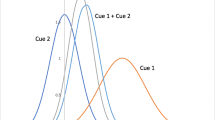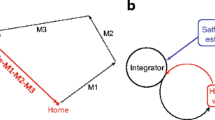Abstract
Planning a path to a destination, given a number of options and obstacles, is a common task. We suggest a two-component cognitive model that combines retrieval of knowledge about the environment with search guided by visual perception. In the first component, subsymbolic information, acquired during navigation, aids in the retrieval of declarative information representing possible paths to take. In the second component, visual information directs the search, which in turn creates knowledge for the first component. The model is implemented using the ACT-R cognitive architecture and makes realistic assumptions about memory access and shifts in visual attention. We present simulation results for memory-based high-level navigation in grid and tree structures, and visual navigation in mazes, varying relevant cognitive (retrieval noise and visual finsts) and environmental (maze and path size) parameters. The visual component is evaluated with data from a multi-robot control experiment, where subjects planned paths for robots to explore a building. We describe a method to compare trajectories without referring to aligned points in the itinerary. The evaluation shows that the model provides a good fit, but also that planning strategies may vary with task loads.
Similar content being viewed by others
References
Anderson JR (1991) The place of cognitive architectures in a rational analysis. In: Van Lehn K (ed) Architectures for intelligence. Lawrence Erlbaum Associates, Mahwah, pp 1–24
Anderson JR (2007) How can the human mind occur in the physical universe? Oxford University Press, Oxford
Balakirsky S, Carpin S, Kleiner A, Lewis M, Visser A, Wang J, Zipara V (2007) Toward hetereogeneous robot teams for disaster mitigation: results and performance metrics from robocup rescue. J Field Robot 24(11–12):943–967
Best BJ, Lebiere C (2006) Cognitive agents interacting in real and virtual worlds. In: Sun R (ed) Cognition and multi-agent interaction: from cognitive modeling to social simulation. Cambridge University Press, New York, pp 186–218
Byrne MD (2006) A theory of visual salience computation in ACT-R. In: Presentation at the thirteenth annual ACT-R workshop, Pittsburgh, PA
Chandrasekaran B (2006) Multimodal cognitive architecture: making perception more central to intelligent behavior. In: Proceedings of the twenty-first AAAI national conference on artificial intelligence. AAAI Press, Boston, pp 1508–1512
Dye HA (2007) Diagrammatic reasoning: route planning on maps with ACT-R. In: Lewis RL, Polk TA, Laird JE (eds) Proceedings of the eighth international conference on cognitive modeling, Ann Arbor, MI, pp 217–218
Fu WT (2003) An ACT-R adaptive planner in a simple map-navigation task. In: Detje F, Doerner D, Schaub H (eds) Proceedings of the fifth international conference on cognitive modeling, Bamberg, Germany, pp 99–104
Fum D, del Missier F (2000) Climbing the mazes: a cognitive model of spatial planning. In: Proceedings of the third international conference on cognitive modeling. Universal Press, Veenendaal, pp 126–133
Glasgow J, Papadias D (1998) Computational imagery. In: Thagard P (ed) Mind readings. MIT Press, Cambridge
Gluck KA, Pew RW (2005) Modeling human behavior with integrated cognitive architectures: comparison, evaluation and validation. Lawrence Erlbaum Associates, Mahwah
Gonzalez C, Lebiere C (2005) Instance-based cognitive models of decision making. In: Zizzo D, Courakis A (eds) Transfer of knowledge in economic decision making. Palgrave McMillan, New York
Hart SG, Stavenland LE (1998) Development of NASA-TLX (task load index): results of empirical and theoretical research. In: Hancock PA, Meshkati N (eds) Human mental workload. Elsevier, Amsterdam, pp 139–183
Hiatt LM, Trafton JG, Harrison AM, Schulz AC (2004) A cognitive model for spatial perspective taking. In: Proceedings of the sixth international conference on cognitive modeling, Pittsburgh, PA, pp 354–355
Johnson T, Wang H, Zhang J, Wang Y (2002) A model of spatio-temporal coding of memory for multidimensional stimuli. In: Gray WD, Schunn C (eds) Proceedings of the 24th annual meeting of the cognitive science society, Fairfax, VA
Kelley TD (2006) Developing a psychological inspired cognitive architecture for robotic control: the symbolic and sub-symbolic robotic intelligence control system (SS-RICS). Int J Adv Robot Syst 3(2)
Kosslyn SM (1980) Image and mind. Harvard University Press, Cambridge
Kosslyn SM (1994) Image and brain. MIT Press, Cambridge
Lathrop SD, Laird JE (2007) Towards incorporating visual imagery into a cognitive architecture. In: Proceedings of the eighth international conference on cognitive modeling, Ann Arbor, MI, pp 25–30
Lebiere C, Wallach D (2001) Sequence learning in the ACT-R cognitive architecture: empirical analysis of a hybrid model. In: Sun R, Giles L (eds) Sequence learning: paradigms, algorithms, and applications. Springer, Berlin
Lewis M, Wang J, Hughes S (2007) USARsim: simulation for the study of human-robot interaction. J Cogn Eng Decis Making 1(1):98–120
Lin L, Goodrich MA (2010) A Bayesian approach to modeling lost person behaviors based on terrain features in wilderness search and rescue. Comput Math Org Theory (this volume)
Lyon DR, Gunzelmann G, Gluck KA (2008) A computational model of spatial visualization capacity. Cogn Psychol 57:122–152
Millán JDR, Torras C (1992) A reinforcement connectionist approach to robot path finding in non-maze-like environments. Mach Learn 8(3–4):363–395
O’Keefe J, Nadel L (1978) The hippocampus as a cognitive map. Oxford University Press, Oxford
Pelz JB, Canosa R (2001) Oculomotor behavior and perceptual strategies in complex tasks. Vis Res 41:3587–3596
Pylyshyn ZW (1989) The role of location indexes in spatial perception: a sketch of the finst spatial-index model. Cognition 32:65–97
Reitter D, Lebiere C (2010) Accountable modeling in ACT-UP, a scalable, rapid-prototyping ACT-R implementation. In: Proceedings of the 10th international conference on cognitive modeling, Philadelphia, PA
Salvucci DD (2001) An integrated model of eye movements and visual encoding. Cogn Syst Res 1:201–220
Sanner S, Anderson JR, Lebiere C, Lovett M (2000) Achieving efficient and cognitively plausible learning in backgammon. In: Proceedings of the seventeenth international conference on machine learning, San Francisco, CA, pp 823–830
Schunn CD, Harrison AM (2001) ACT-RS: A neuropsychologically inspired module for spatial reasoning. In: Proceedings of the fourth international conference on cognitive modeling, Fairfax, VA, pp 267–268
Shepard RN, Metzler J (1971) Mental rotation of three-dimensional objects. Science 171:701–703
Simon H (1991) Cognitive architectures in a rational analysis: comment. In: Van Lehn K (ed) Architectures for intelligence. Lawrence Erlbaum Associates, Mahwah, pp 25–40
Wang H, Lewis M, Velagapudi P, Scerri P, Sycara K (2009) How search and its subtasks scale in N robots. In: Proceedings of the 4th ACM/IEEE international conference on human robot interaction. ACM, New York, pp 141–148
West RL, Stewart TC, Lebiere C, Chandrasekharan S (2005) Stochastic resonance in human cognition: ACT-R vs. game theory, associative neural networks, recursive neural networks, q-learning, and humans. In: Bara LBMB (ed) Proceedings of the twenty-seventh annual conference of the cognitive science society, Stresa, Italy, pp 2353–2358
Wray R, Lebiere C, Weinstein P, Jha K, Springer J, Belding T, Best B, Parunak V (2007) Towards a complete, multi-level cognitive architecture. In: Lewis RL, Polk TA, Laird JE (eds) Proceedings of the eighth international conference on cognitive modeling, Ann Arbor, MI, pp 325–330
Author information
Authors and Affiliations
Corresponding author
Rights and permissions
About this article
Cite this article
Reitter, D., Lebiere, C. A cognitive model of spatial path-planning. Comput Math Organ Theory 16, 220–245 (2010). https://doi.org/10.1007/s10588-010-9073-3
Published:
Issue Date:
DOI: https://doi.org/10.1007/s10588-010-9073-3




